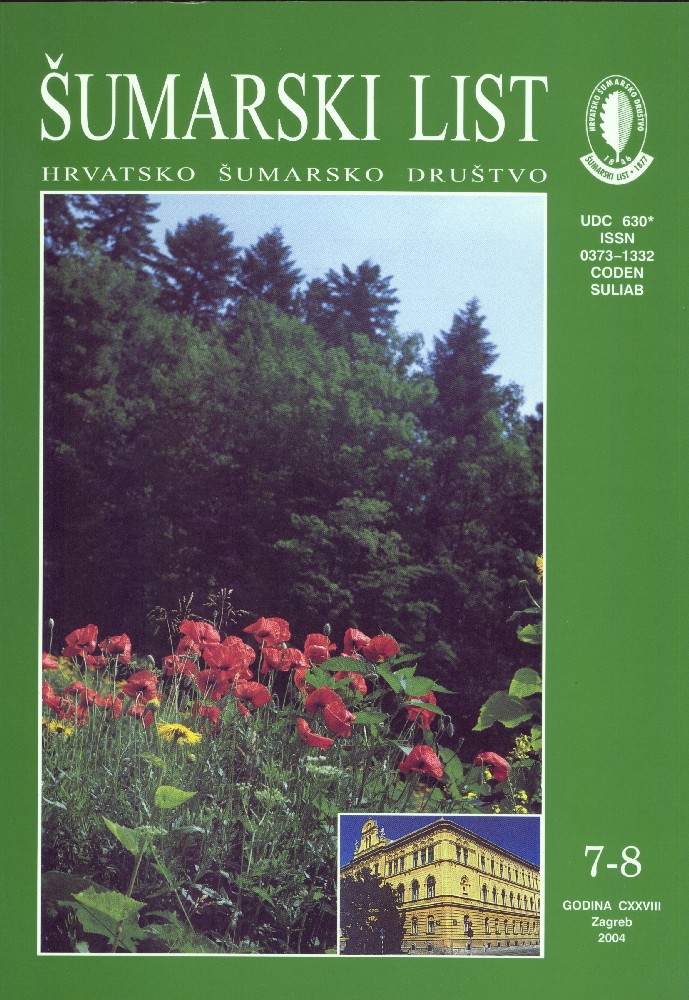
broj: 7-8/2004
pdf (29,5 MB) |
|
||||||||||||||
| IZVORNI ZNANSTVENI ČLANCI | ||
| Pilaš, I., Seletković, A. | UDK 630* 181.3 + 581 | |
| An Analysis of Groundwater Regime of Lowland Našice Forest Area by Use of Grass Gis pdf HR EN | 363 | |
| Trinajstić, I. | UDK 630* 188 | |
| Nomenclatural and Syntaxonomic Revision of the Complex “Blechno-Fagetum (Ht. 1950) Ex Marinček 1970” (Luzulo-Fagion) pdf HR EN | 375 | |
| Zečić, Ž., Poršinsky, T., Šušnjar, M. | UDK 630* 305 + 242 | |
| Some Harvesting Results in Hilly Thinning Stands by Group Labor With a Review of Selection of Time Study Method pdf HR EN | 381 | |
| Prka, M. | UDK 630* 523 (Fagus sylvatica L.) | |
| Bark Thicknees of Common Beech (Fagus sylvatica L.) in Cutting Areas of Bilogora near Bjelovar pdf HR EN | 391 | |
| Krejči, V., Dubravac, T. | UDK 630* 231 + 226 (Quercus ilex L.) | |
| From Coppice Wood to High Forest of Evergreen Oak (Quercus Ilex L.) by Shelterwood Cutting pdf HR EN | 405 | |
| Crnković, S. | UDK 630* 232.3 (Quercus robur L.) | |
| Quantitative and Qualitative Properties of Common Oak Acorn (Quercus robur L.) in the Stands of the Basin of the Česma River pdf HR EN | 413 | |
| Summary: Life of every forest stand begins and ends with a seed – important factor in life of every forest ecosystem. This work surveys quantitative and qualitative properties of common oak acorn (Quercus robur L.), and the author wanted to examine if they differ in pedunculate oak stands on beam from those in valleys, that is, if there are differences in middle aged, older and old stands. On the area of four Management units of the basin of the Česma river, on 198 experimental plots (2 x 2m) in 24 pedunculate oak stands, entire acorn was collected. Its total quantity and the quantity of visibly healthy acorn was determined as well as its share by 1 hectare, number of seeds in 1 kg, and its dimensions. The Forestry Institute in Jastrebarsko made the analysis of the collected acorn samples by method of quick germination in a germinaiton container. Their nursery germination, number of plants at the end of the first year, as well as their hight, have been observed in the forest nursery “Zdenački gaj”, part of the forestry unit Grubišno Polje, Management Office Bjelovar.Climatic conditions were in favour of the good pedunculate oak acorn crop on the surveyed area in 1998, and the average of 518 914 pieces or 1 925 kg of acorn were collected on 1 hectare. 263 431 pieces of the total quantity were healthy, or 1 197 kg. The share of the visibly healthy acorn in average was 50,89 % (pcs/ha), that is 62,28 % (kg/ha) which shows the need of stricter quality control at the time of its purchace. The best crop the surveyed area, per surface, was from the stands of the Management unit “Bolčanski – Žabljački lug”, whose acorn had the biggest absolute weight and best laboratory germination, and whose plants in the nursery at the end of the first year, were highest. The biggest share of the visibly healthy acorn was in the samples coming from the Management unit “Dugački gaj – Jasenova – Drljež”, while the acorn originating from the Management unit “Česma”, was best preserved during winter. The biggest nursery germination and the biggest percentage of the plants number at the end of the first year, was noted for the samples originating from the Management unit “Čazmanske nizinske šume”. Samples of the forest of pedunculate oak with the great greenweed in all measured and observed properties (except in laboratory germination and acorn width) have shown better than samples originating from forest of pedunculate oak and common hornbeam. On the surveyed area the old stands had the best generated with acorn and they had the biggest nursery germination as well as the percentage number of plants at the end of the first year. The samples taken from the middle – aged stands had the biggest share of visibly healthy acorn and their acorn was best kept during winter, while the samples taken from older stands had the acorn of the biggest absolute weight, biggest length and best laboratory germination. At the end of the first year, the plants for those samples, were of the highest average hight in the nursery. Over the surveyed area, on the total of 8 236,34 ha of stands of the Management Class of pedunculate oak older than 50 years, theoretically, out of the 1998 crop, more than seven thousand oak acorn could have been collected. | ||
| PRETHODNO PRIOPĆENJE | ||
| Zelić, J. | UDK 630* 525 (quercus frainetto ten) | |
| Preliminary Sortiment Tables for Italian Oak (Quercus Frainetto Ten) pdf HR EN | 431 | |


